Transportation system demand
This article refers to the address: http://
The input voltage to the transportation system can be as high as 14V (single-battery-powered cars), 28V (dual-battery-powered trucks, buses, and airplanes), or higher, while digital systems require one or more low-voltage rails. Therefore, when designing such a system, it is necessary to understand how to depressurize from a very high input voltage simply, efficiently and reliably. Figure 1 below shows that the input voltage in an automotive environment may change depending on its operating state, and its operating conditions may include various conditions in which load dump changes to cold start, or even reverse battery connections.
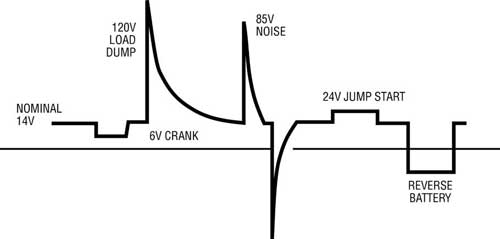
Figure 1: Typical automotive transients
NOMINAL 14V: nominal 14V
120V LOAD DUMP: 120V load dump
6V CRANK: 6V cold car launch
85V NOISE: 85V noise
24V JUMP START: 24V suddenly start
REVERSE BATTERY: Battery reverse connection
Switching regulator solutions are helpful when applications require power conversion at very high efficiency to minimize heat loss due to power loss during conversion. Switching regulators are essentially monolithic devices with on-chip MOSFETs in either synchronous or non-synchronous configurations. Alternatively, the switching regulator can be comprised of a switching controller that drives an external MOSFET in a single or multi-stage topology (multi-phase) to provide tens of amps to hundreds of amps. To meet such large power range requirements, Analog Devices offers a wide range of switching regulator solutions to enable users to select the most suitable device for the specific design criteria required for the final system. Correspondingly, our switching regulators have a very wide input voltage range (from 5V up to 150V) with output power levels from hundreds of mA to over 1,000A.
An example of such a switching regulator is the LTC3895, a synchronous buck converter with a 150V input that can be configured for multiphase operation, as shown in Figure 2.
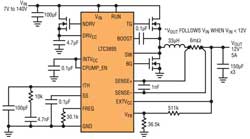
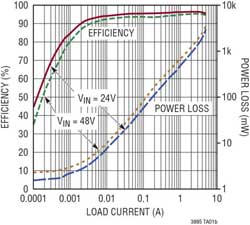
Figure 2: LTC3895 schematic and efficiency versus power loss curve
VOUT FOLLOWS VIN WHEN VIN < 12V: VIN < 12V, VOUT follows VIN
EFFICIENCY: Efficiency
POWER LOSS: Power Loss
LOAD CURRENT: load current
There is a common problem in any transportation system: how can a solution with a high step-down ratio and a compact footprint be achieved without compromising performance and conversion efficiency? Until recently, there was still no solution. Meet all key performance criteria without sacrificing other performance. However, with the introduction of Analog Devices' single-chip, 2MHz-plus, synchronous buck converter LT86xx series, all necessary performance standards are immediately met.
A good example is the LT8609, a 2A, 42V input synchronous buck switching regulator. The unique synchronous rectification topology provides 93% efficiency, while switching at 2MHz allows designers to avoid critical noise-sensitive frequency bands, such as AM radios, while providing a very compact solution footprint. Burst Mode ® operation keeps quiescent current below 2.5μA in no-load standby, making the device ideal for systems that are always on. The LT8609's 3.0V to 42V input voltage range makes it ideal for automotive applications where it must be stable with cold start and stop-start conditions with a minimum input voltage as low as 3.0V and stable through load transients of over 40V. Its internal 3.5A switch provides up to 2A of continuous output current at a peak load current of 3A. The schematic and the efficiency curve corresponding to the 2MHz switching frequency are shown in Figure 3.
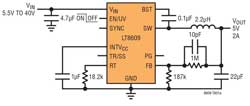
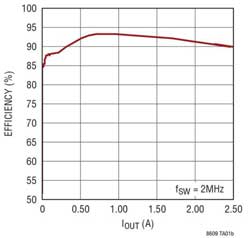
Figure 3: LT8609 schematic and efficiency curve
Because of the common cold engine launch and load dump in single or dual battery powered vehicles, many transportation systems offer a wide input voltage range. What makes the situation even more complicated is that the required output voltage is likely to exceed this already wide input voltage range. Therefore, the complex problem faced by system designers is that the designed solution must allow a fixed output regardless of whether the input voltage is above, below or equal to the output voltage.
A common way to solve this problem is to use a SEPIC topology converter. However, the design of this converter is complex, requires two inductors, and usually has low space utilization and conversion efficiency. As a result, Analog Devices has designed a wide range of 4-switch buck-boost controllers that simplify design and provide high space utilization and conversion efficiency with power losses between 5% and 7% ( Depending on the input to output voltage range). The LT8705, shown in Figure 4, is an example of a buck-boost controller with a 4V to 80V input that provides a fixed 12V output common in vehicle environments.
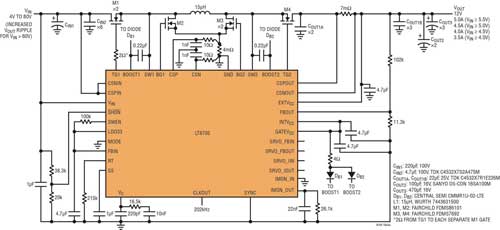
Figure 4: Detailed LT8705 schematic with fixed 12V output from 4V to 80V input
INCREASED VOUT RIPPLE FOR VIN > 60V: VIN > 60V, VOUT ripple increases
Another way to solve the problem of car cold car launch is to use a boost converter followed by a buck converter. In this topology, the output of the boost converter from a single cell is set to a few volts above the nominal voltage of the battery, and then stepped down by a buck converter to bring it downstream. The operating voltage required for the electronic components. Although this approach requires two converters, Analog Devices has developed a device that integrates a boost controller and a buck controller. Both controllers can be used independently or as boost-drop Pressure follower is used. The operation of this device is illustrated in Figure 5 using the LTC7813.
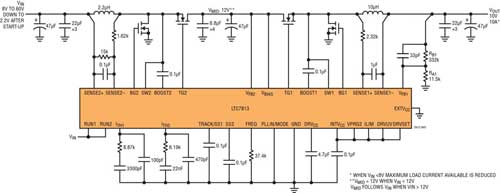
Figure 5: LTC7813 Schematic ~~ A Cascaded Step-Up and Step-Down Single Output Controller IC
8V TO 60V DOWN TO 2.2V AFTER START-UP: 8V to 60V, reduced to 2.2V after startup
Low noise power management
Electromagnetic Radiation (EMR), Electromagnetic Interference (EMI), and Electromagnetic Compatibility (EMC) are terms associated with charged particles and the energy associated with a magnetic field that can affect circuit performance and interfere with signal transmission. With the popularity of wireless communication, the emergence of a large number of communication devices, and the increasing number of communication methods, occupying more and more spectrum (some bands are overlapping each other), electromagnetic interference has become a lingering fact. In order to mitigate the effects of electromagnetic interference, many government agencies and regulatory agencies have set electromagnetic radiation limits for communication equipment and instrumentation.
Therefore, it is clear that low radiation is a key requirement for many automotive and transportation equipment manufacturers. How can a system designer meet the stringent requirements of automotive CISPR 25, Class 5 (shown in Figure 6) while still maintaining high efficiency and small solution size?
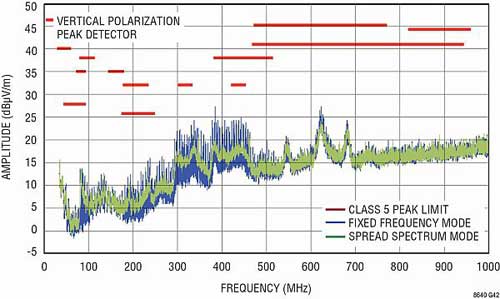
Figure 6a: The radiance of the LT8614 is much lower than the CISPR25, Class 5 limits.
AMPLITUDE: Amplitude
VERTICAL POLARIZATION: vertical polarization
PEAK DETECTOR: Peak Detector
CLASS 5 PEAK LIMIT: Class 5 peak limit
FIXED FREQUENCY MODE: Fixed frequency mode
SPREAD SPECTRUM MODE: Spread Spectrum Mode
FREQUENCY: Frequency
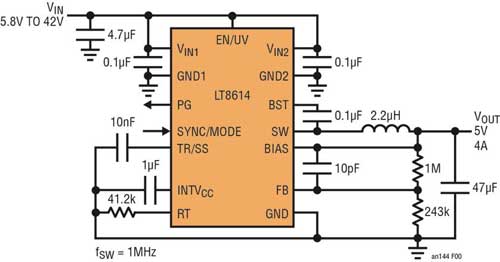
Figure 6b: LT8614 with Silent Switcher topology
One answer might be using ADI's Silent Switcher ® family of devices. Take the LT8614 as an example. This is a 42V input, 4A output, monolithic step-down converter that switches at a switching frequency higher than 2MHz and a conversion efficiency of 94% due to its short 30ns minimum on-time. It can meet the step-down ratio of 16V input to 1.8V output. In addition, thanks to the patented Silent Switcher technology, the device exceeds CISPR 25 and CISPR 22 Class B radiation requirements, as shown in Figure 7.
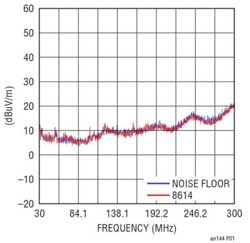
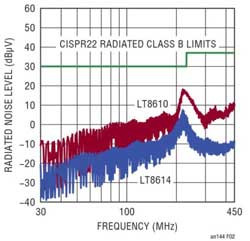
Figure 7: LT8614 meets CISPR 22 and CISPR 25 requirements
NOISE FLOOR: noise floor
FREQUENCY: Frequency
RADIATED NOISE LEVEL: Radiated noise value
CISPR 22 RADIATED CLASS B LIMITS: CISPR 22 Class B Radiation Limit
Low quiescent current is also a key requirement
In transportation electronic systems, there are many applications that require continuous power supply, even after the vehicle has been parked, such as remote keyless entry, security, and even personal infotainment systems, which typically include navigation, GPS positioning, and emergency call systems. It may be difficult to understand why these systems must remain connected even when the vehicle is not exercising, but it is understandable that in order to respond to emergencies and ensure safety, the GPS system must be “always onâ€. This requirement is necessary to apply basic control functions through external operations when needed.
A key requirement for this type of application is low quiescent current to extend battery life. Since 2010, ADI has been producing switching regulators with standby quiescent currents below 10mA, and some of our newer products have recently had standby quiescent currents below 2mA. Therefore, these products are well prepared for use in many automotive electronic systems.
in conclusion
ADI offers a wide range of switching regulator products that meet all of the requirements for switching regulators, and the features of these products are ideal for a variety of transportation systems, including:
· Wide input voltage range: 2.xV to 150V
· Low quiescent current in standby mode: typically less than 10mA
· Minimum output noise and very low EMI / EMC radiation
· Extended temperature range: guaranteed operation at 150 °C ambient temperature and junction temperature
· High efficiency: up to 97% at full load and up to 80% at light load
· Low thermal resistance package: as low as 10 ° C / W (qjc)
· Operates at high step-down ratio and high switching frequency: up to 4MHz
High current density: up to 5A continuous output current in a 3mm x 5mm MSOP package
· Industry leading FIT rate: typically less than 0.2
Perfume Lotus Tea Perfume Lotus TeaPerfume test
development, production and sales. We have improved quality control processes of L Shape Standing Desk to ensure each export qualified product.
If you want to know more about the products in L Shape Standing Desk, please click the product details to view parameters, models, pictures, prices and other information about L Shape Standing Desk,Standing Desk L Shape,development, production and sales. We have improved quality control processes of L Shape Standing Desk to ensure each export qualified product.
If you want to know more about the products in L Shape Standing Desk, please click the product details to view parameters, models, pictures, prices and other information about L Shape Standing Desk,Standing Desk L Shape,
Bossgoo(China)Tecgnology , https://www.cn-gangdao.com